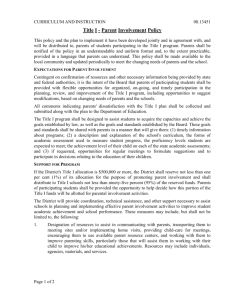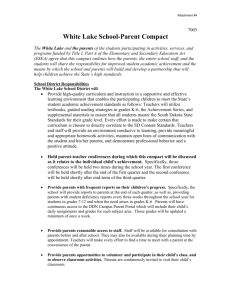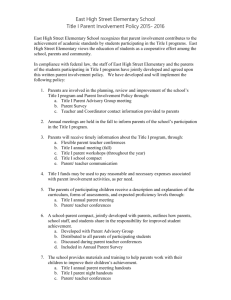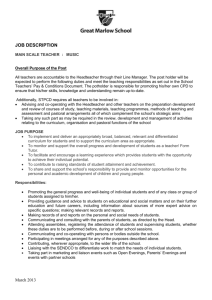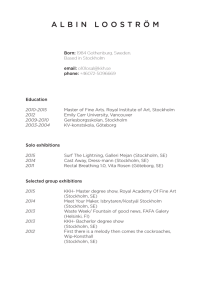The Proposed Project - Global Environment Facility
advertisement
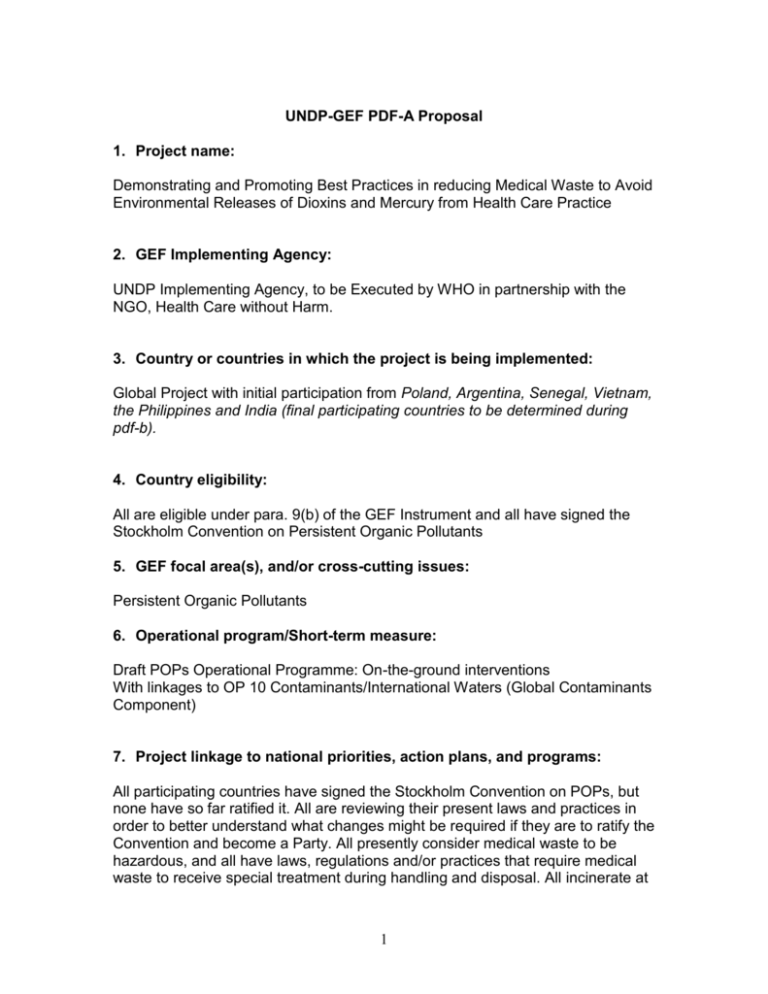
UNDP-GEF PDF-A Proposal 1. Project name: Demonstrating and Promoting Best Practices in reducing Medical Waste to Avoid Environmental Releases of Dioxins and Mercury from Health Care Practice 2. GEF Implementing Agency: UNDP Implementing Agency, to be Executed by WHO in partnership with the NGO, Health Care without Harm. 3. Country or countries in which the project is being implemented: Global Project with initial participation from Poland, Argentina, Senegal, Vietnam, the Philippines and India (final participating countries to be determined during pdf-b). 4. Country eligibility: All are eligible under para. 9(b) of the GEF Instrument and all have signed the Stockholm Convention on Persistent Organic Pollutants 5. GEF focal area(s), and/or cross-cutting issues: Persistent Organic Pollutants 6. Operational program/Short-term measure: Draft POPs Operational Programme: On-the-ground interventions With linkages to OP 10 Contaminants/International Waters (Global Contaminants Component) 7. Project linkage to national priorities, action plans, and programs: All participating countries have signed the Stockholm Convention on POPs, but none have so far ratified it. All are reviewing their present laws and practices in order to better understand what changes might be required if they are to ratify the Convention and become a Party. All presently consider medical waste to be hazardous, and all have laws, regulations and/or practices that require medical waste to receive special treatment during handling and disposal. All incinerate at 1 least some portion of their medical waste and recognize that some quantities of by-product POPs and mercury are released to the environment during this activity. Most are also entertaining proposals for the construction of new medical waste incinerators. All wish to explore the implementation of best practices that can reduce the amount of medical waste generated, and can by this and other means, avoid environmental releases of dioxins and mercury from health care practice. Vietnam provides an example of the situation facing counties proposed for participation in this Project. The Government of Vietnam pays attention to the management of medical wastes by several activities. The Ministry of Science, Technology and Environment (MOSTE) has organized courses on medical waste management and control for provincial authorities, hospitals and other medical care organizations. In some hospitals, the approach has been to start separating medical wastes at source by using different waste bag colors. In some other hospitals, the approach has been to set up incinerators. Many different authorities are involved in medical waste management. These include the Ministry of Health (MOH), MOSTE, Ministry of Construction (MOC), Ministry of Labor, Invalids and Social Affairs (MOLISA), the provincial authorities (DOSTE, DOH, Preventive Medicine Centers…) and others. Vietnam recognizes that due to inadequate and poor management of medical wastes, some diseases occur with increased frequency. These include infectious diseases such as petechial fever, malaria, diarrhea, hepatitis B and C. Present legislation – for example, Decision No. 152/1999/QD-TTg of the Premier dated 10 July 1999 – establishes a target objective, by 2005, to treat medical wastes in large urban areas by best available incineration; and by 2020, collection and strict disposal of medical wastes in the urban areas by advanced technology. On the other hand, Vietnam recognizes that it lacks knowledge and experience in medical waste management. It therefore wishes to participate in this Project in order to help it: - Perfect the legal system of medical waste management such as regulations, technical guidelines…. - Train its people and experts in hospital waste management; - Reduce the dioxin and mercury emission by application the new technology of the medical waste treatment to avoid the incinerator; 2 - Increase public awareness about POP and other PTS within the medical and health care sector; and - Link this to their National Implementation Plan for POPs under the Stockholm Convention. 8. GEF national operational focal point and date of country endorsement: Argentina – Juan Carlos Carlaguso, Ministerio de Relacions Exeriores, Comercio Internacional y Culto: 21 May 2002 India – S.K. Joshi, Director, International Cooperation, Ministry of Environment and Forests: 18 June 2002 Senegal – Fatima Toure, Ministere de la Jeunesse, de l’Environment et de l’Hygiene Publique: 4 December 2001 Poland – Maciej Nowicki, President, Ecofundusz: 28 May 2002 Philippines – Gregorio V. Cabantac, Department of Environment and Natural Resources: 25 February 2002 Vietnam – Nguyen Ngoc Sinh, General Director and Vice-Chairman of GEFVietnam, National Environment Agency: 21 January 2002 9. Project rationale and objectives: Persistent organic pollutants (POPs) and other persistent toxic substances (PTSs) enter the environment in quantities of significant concern as a result of the activities of hospitals and clinics, and also from other forms of health care practice. These contaminants of concern include polychlorinated dibenzo-Pdioxins and dibenzofurans (PCDD/PCDF) also called “dioxins” and “furans.” (We will henceforth refer to this class of contaminants as dioxins.) Mercury also enters the environment as a result of health care practice. The main pathway related to health care practice through which dioxins and mercury enter the environment is the incineration or combustion of medical wastes; although mercury also enters the environment directly as a result of breakage in thermometers and other mercury-containing health care instruments. In many countries, the incineration or the combustion of medical waste has been identified as the country’s second or third largest source of dioxin and can also be an important source of mercury emissions. In the United States, for example, according to USEPA, medical waste incinerators may be responsible for as much as 10% of all mercury air releases;1 and health care facilities may be also responsible for as much as 5% of all mercury releases in waste water.2 With regard to dioxin, USEPA reports that in 1 2 USEPA Mercury Study Report to Congress, 1997 Public Health Report, July-August 1999 3 reference year 1995, medical waste incinerators (MWIs) were the third largest source of dioxin emissions in the country (following municipal solid waste incineration and secondary copper smelting). According to USEPA: “The central estimate of TEQ emissions in 1995 is estimated to be 477 g/yr, with a range of 151 to 1,510 g/yr.” 3 This amounts to 17% of the total dioxin emissions listed in the Report. More telling, US EPA’s central estimate of dioxin emissions from MWIs in its 1987 Report was 2,470 g/yr – a full five times higher than reported for 1995. According to the 1995 Report: “the total number of operating MWIs and the total amount of waste combusted decreased by more than 50 percent [between 1987 and 1995]. Certain activities caused this to occur, including more stringent air pollution control requirements by State regulatory agencies and the development of less expensive medical waste treatment technologies, such as autoclaving (Federal Register, 1997b). Because many MWIs have small waste charging capacity (i.e., about 50 metric tons per day), the installation of even elementary APCDs [air pollution control devices] proved not to be cost effective. Thus, a large number of facilities elected to close rather than retrofit.”4 The US and other OECD countries have been shutting down medical waste incinerators and reducing the total amounts of waste sent to dedicated MWIs. This has helped them substantially decrease dioxin emissions. However, the trends and pressures in developing countries and countries in transition appear to be moving in the opposite direction. New MWIs are being proposed and built in these countries, very often ones with small waste charging capacity, and without sufficient APCDs. This is the category whose closure in the US (between 1987 and 1995) achieved a reduction in almost 2,000 g/yr TEQ. (To put this number in context, the total reported US Dioxin emissions from all reported sources in 1995 was less than 3,000 g/yr TEQ.) As an example of the trend toward promotion of new MWIs in developing countries, consider the proceedings of a Regional Immunization Safety Workshop held in Colombo, Sri Lanka in November 2000. One goal was to develop a regional framework that would ensure safety issues are addressed in a comprehensive and integrated manner. In the proceedings of the Workshop, under the heading: “Sharps Management and Safe Disposal,” it reads: “Two options for incineration of syringes and needles are currently available: 3 4 USEPA, The Inventory of Sources of Dioxin in the United States, 1998 (Review Draft) Ibid 4 Purpose-designed incinerators: built on site to meet local needs, usually using local materials Factory-built incinerators: imported ready – made by the purchasing country and installed in place. If no incineration is available, syringes can be burned in metal drums or barrels or in a brick-built enclosure. Alternatively the wastes could be buried in a deep hole or pit in the ground. In many cases, development experts still remain unaware of the environmental consequences of waste incineration, and they often do not realize that there are other cost-effective waste disposal alternative options. With the adoption of the Stockholm Convention in May 2001, this situation will be changing. Parties will be obligated to reduce total releases of dioxins derived from anthropogenic sources with the goal of their continuing minimization and, where feasible, ultimate elimination. GEF is the interim financial mechanism for the Stockholm Convention. In addition, both mercury and dioxins have been identified as persistent toxic substances of global concern causing significant contamination of International Waters. Under OP 10 – the Contaminant-Based Operational Program – GEF supports activities that help demonstrate ways of overcoming barriers to the adoption of best practices to limit the contamination of international waters. However, while there is growing intergovernmental concern and attention to the injury POPs and PTSs cause to human health and the environment, there also exists serious and growing international concern about infectious diseases such as HIV, hepatitis B and hepatitis C. Concern about these diseases has encouraged an increased trend in health care facilities around the world to move toward one-time use syringes (which is often a positive development). It has also, however, encouraged a substantial increase in the trend toward utilization of many other one-time use health care products that are often unnecessary and unwarranted under conditions in developing countries. As a result, many countries are now seeing a massive expansion in their generation of medical waste. Poor management of medical waste also leads to occupational hazards for workers that come in contact with the waste. Additionally, in some countries contaminated medical waste may be diverted from the waste stream and packaged for reuse. Or, contaminated medical waste may be scavenged from waste areas and dumping sites and is then either reused or re-sold. According to a 1999 study, it is estimated that injections with non-sterile syringes may cause 8 5 - 16 million hepatitis B infections, 2.3 to 4.7 million hepatitis C infections, and 80 000 to 160 000 HIV infections per year.5 Improper management of health care waste is one important reason for the uncontrolled spread of non-sterile syringes. Still, in most developing countries and countries in transition, sufficient funds and budgets are rarely available for good health care waste management. However, when health professionals are pressed to come to terms with the burgeoning health care waste crisis, often, the first response is to seek to solve this problem by burning the waste, and often, this has been the advice they have received from development experts. The incineration is often accomplished at low temperatures and/or in uncontrolled and poorly controlled incinerators and the new incinerators become large new sources for emissions and releases of dioxin and mercury to the environment. Even high temperature incinerators often have a poor track record. In many developing countries incinerators often are not properly operated and maintained and trained personnel are not available to run the equipment. At present, in most countries, health professionals tend to have a very limited knowledge and awareness about toxic contaminants that enter the environment and that can injure human health. They often see burning or incineration of health care wastes to be a positive public health measure. However, health care professionals are generally quite receptive to information about toxic environmental contaminants, and the health injuries they can cause. When health care professionals are informed about this, most will support alternative waste management approaches that can achieve results that are as good or better without generating and/or releasing environmental contaminants such as POPs and PTSs. Additionally, when health care professionals become informed and aware about POPs and PTSs and the injury they cause, this makes an important contribution toward more general efforts at public information, awareness and education about POPs as called for in Article 10 of the Stockholm Convention. The Proposed Project The Proposed Project is a Global Project to demonstrate best practices in the management of health care wastes with the intent of minimizing and eliminating releases of dioxins and mercury to the environment, and also to demonstrate ways of overcoming barriers to their adoption. This Project will operate in several 5 Kane A, et al., 1999. Transmission of hepatitis B, hepatitis C and human immunodeficiency viruses through unsafe injections in the developing world: model-based regional estimates. Bulletin of the World Health Organization, 1999, 77(10):801-807. 6 countries, and in up to five regions. (The full number and the identity of all countries and regions participating will be determined during PDF A/B activities.) In each participating country, this Demonstration Project will be administered and will operate separately from the country’s Stockholm Convention Enabling Activities Project. It will, however, provide regular reports and updates on progress to the country Enabling Activity Project. Further, it is anticipated that upon successful completion of the Demonstration Project, measures and methodologies established under this Project will be fully integrated into the country’s Stockholm National Implementation Plan. Under the PDF A, an international meeting will be organized. Each participating government will nominate a national expert to attend who has experience in medical waste management, and who also has experience with national medical waste policy. Experts from WHO, HCWH and UNDP will participate; as will NGO experts from several of the participating countries (to be nominated by HCWH). Invitations will also be extended to other relevant IGOs and NGOs as appropriate. This meeting will discuss this Project Proposal. It will review, revise and provide more details than are provided in this PDF A proposal. The outputs of this meeting will then be used to provide guidance in the development of a Concept Paper and a PDF B Project Proposal for submission to the GEF. The meeting may also consider the total number of countries and regions that will be identified in the PDF B proposal for participation in the full Project. In broad outline, the Project will demonstrate best practices in the management of health care wastes in a number of countries and regions to minimize dioxin and mercury releases; and it will establish national and/or regional programs in participating countries to train experts who can then replicate the program at other hospitals and facilities. Under this Project, best practices will include: Techniques for waste minimization; Segregation of infectious wastes from ordinary wastes; Selection and utilization of appropriate waste treatment approaches. In each participating country, the Project will identify one large hospital and several smaller clinics and/or rural health or injection programs. It will work with the staff at these facilities to develop and implement best practices. Under this activity, the Project will: Review, at each participating facility, existing waste management practices and policies, including purchase and product utilization policies; 7 Review national policies, laws and regulations regarding hospital waste management with an aim towards formulating proposals for reform; Establish waste minimization and waste management objectives for each facility; propose and adopt modifications in current practices and policies aimed at achieving objectives; Establish management structures and management techniques to assure new policies and practices will be properly carried out; Train both managers and staff to carry out the new policies and practices; Select and deploy appropriate waste treatment approaches; Monitor and review progress; provide ongoing support and assistance to ensure objectives are being met; revise approaches as needed; Establish a countrywide or regional training program, with access to the facility, to train and certify experts who can then implement similar best practices at other health facilities in the country and/or region. Prepare and disseminate awareness raising materials (print, electronic) summarizing best practices in hospital waste management. Convene a National Conference on Health Care Waste management to present Demonstration Project outcomes; to begin national dialogue toward the development of a National Health Care Waste Management Action Plan; and to launch Health Care Waste Management expert training programs. Based on Project success, participating hospitals and facilities will enter into a memorandum of understanding or a contractual agreement with the government and/or some other appropriate institution committing them to continue waste minimization and other best waste management practices after the Project is completed. This agreement or contract will also include terms under which country and/or regional waste management expert training programs can retain access to the facility as a way to demonstrate best practices in an actual health care setting. Additionally, the country will undertake a review of its existing national waste management legislation and regulations; and it will undertake to reform these, as appropriate. This Proposed Project is especially relevant to certain, specific provisions of the Stockholm Convention. These are provisions all Parties will be obligated to begin implementing when the Convention enters into force. It is important that this Full 8 Project has already been operating and producing results before that time, since it can then serve as a model for measures that participating and other countries may choose to adopt. Annex C of the Stockholm Convention addresses dioxins (and other unintentional by-product POPs). Part II of this Annex is a relatively short list of source categories that “have the potential for comparatively high formation and release of these chemicals [i.e. dioxins] to the environment. The very first entry on this list is: “Waste incinerators, including co-incinerators of municipal, hazardous or medical waste or of sewage sludge.” Article 5 of the Stockholm Convention addresses measures that Parties to the Convention shall take to reduce releases of dioxins (and other unintended byproduct POPs) with the goal of their continuing minimization and, where feasible, ultimate elimination. Parties are required to promote best available techniques for both new sources and existing sources listed in Part II of Annex C – which (as indicated above) includes medical waste incinerators. For the new sources listed in Part II – which includes any new or any substantially modified facility for incineration or combustion of medical waste – Parties are required to use best available techniques. This requirement is to be “phased in as soon as practicable but no later than four years after entry into force of the Convention for the Party.” Best available techniques are addressed in Annex C, Part V (although further guidelines are to be developed by the Conference of the Parties). Part V, paragraph A, subparagraph (f) states: “When considering proposals to construct new waste disposal facilities, consideration should be given to alternatives such as activities to minimize the generation of municipal and medical waste, including resource recovery, reuse, recycling, waste separation and promoting products that generate less waste. Under this approach, public health concerns should be carefully considered.” In addition, in paragraph B, subparagraph (b), we read that when Parties are considering proposals to construct new facilities using processes that release dioxins (e.g. waste combustion processes): “[P]riority consideration should be given to alternative processes, techniques or practices that have similar usefulness but which avoid the formation and release of such chemicals (i.e. dioxins).” The proposed Project will demonstrate best practices for medical waste management that can avoid the need for incineration or combustion by means that include, inter alia: reuse, recycling, waste separation and the promotion and use of products that generate less toxic and lower volumes of wastes. It will demonstrate alternative processes, techniques and practices that – taken 9 together – can achieve the same usefulness as incineration or combustion of medical waste but which avoids the formation of dioxins and the release of dioxins and mercury. It will also advance provisions under Article 10 of the Stockholm Convention on Public Awareness. Increasing awareness about POPs within the country’s medical and health care sector is one key step in raising credible public awareness in civil society as a whole. 10. Expected outcomes: Best Practices in reducing Medical Waste to Avoid Environmental Releases of Dioxins and Mercury from Health Care Practice will be demonstrated in several countries in two or more regions. Participating hospitals and facilities will enter into a memorandum of understanding or a contractual agreement with the government and/or some other appropriate institution committing them to continue waste minimization and other demonstrated best waste management practices after the Project is completed. Countrywide or regional training programs will be established in participating countries to train and certify experts who can then implement similar best practices at other health facilities in the country and/or region. Participating countries will review existing national waste management legislation and regulations, and will reform these, as appropriate. Measures and methodologies established under this Project will be shared with the country Stockholm Convention Enabling Activities Project, and as appropriate, will be integrated into each participating country’s Stockholm National Implementation Plan (NIP). Increased awareness in participating countries about POPs and other PTSs within the medical and health care sector. This can be seen as a key step in raising credible public awareness in civil society as a whole helping fulfill, inter alia, Stockholm Convention, Article 10 provisions on Public Awareness. Successful demonstration Project will create a model for measures other countries in all regions can choose to adopt in the development of their own Stockholm Convention NIPS. 10 11. Planned activities to achieve outcomes: In each participating country, the Project will identify one large hospital and several smaller clinics and/or rural health or injection programs. It will work with the staff at these facilities to develop and implement best practices. Under this activity, the Project will: Review, at each participating facility, existing waste management practices and policies, including purchase and product utilization policies; Establish waste minimization and waste management objectives for each facility; propose and adopt modifications in current practices and policies aimed at achieving objectives; Establish management structures and management techniques to assure new policies and practices will be properly carried out; Train both managers and staff to carry out the new policies and practices; Select and deploy appropriate waste treatment approaches; Monitor and review progress; provide ongoing support and assistance to assure objectives are being met; revise approaches as needed; Establish a countrywide or regional training program, with access to the facility, to train and certify experts who can then implement similar best practices at other health facilities in the country and/or region. Establish contracts or MOUs between participating facilities and the government (and/or other appropriate institution) committing the facility to continue waste minimization and other best waste management practices after the Project is completed, and ensuring that expert training programs can retain access to the facility as a way to demonstrate best practices in an actual health care setting. At the country level, participating countries will convene National Conferences on Health Care Waste management to present Demonstration Project outcomes; to begin national dialogue toward the development of a National Health Care Waste Management Action Plan; and to launch Health Care Waste Management expert training programs. Countries will review existing national waste management legislation and regulations and will reform these, as appropriate. The project will also coordinate with and provide regular reports and updates on progress to each participating country’s POPs Enabling Activity Project, so as to facilitate integration of measures and methodologies established under this 11 Project, as appropriate, into the country’s Stockholm Convention National Implementation Plan. 12. Stakeholders involved in project: At the international level, WHO and UNDP will collaborate in the preparation and implementation of the Project with the international NGO coalition, Health Care Without Harm (HCWH), and with a number of NGOs and institutions affiliated to it. In each country, the Environment Ministry and the Health Ministry will collaborate in Project execution with one or more appropriate NGOs including affiliates of HCWH. In some countries, the HCWH participating NGO partner has already been identified; and in some others, it is still to be identified. Poland Waste Prevention Association India Srishti Philippines IPEN Southern Co-Chair Argentina Asociación Argentina de Médicos por el Medio Ambiente, AAMMA Senegal To be determined Vietnam To be determined During the PDF A stage of the Project, an effort will be made to expand the stakeholder groups involved. Possibilities include the World Federation of Public Health Associations and country affiliates; as well as other professional associations representing physicians, nurses and other healthcare workers. PART II - INFORMATION ON BLOCK A PDF ACTIVITIES 13. Activities to be financed by the PDF: Under the Block A, funds will be utilized to organize and hold an international meeting. Meeting participants will include government experts in waste management practice and policy from each of the initial sponsoring countries (Vietnam Argentina, Senegal, Poland, India and the Philippines), several NGO experts with direct experience in the participating countries; experts from the World Health Organization, Health Care Without Harm, and UNDP; as well as other potential stakeholders, and possibly other potential co-financing institutions. 12 The Purpose of the meeting will be: to review this proposal; to elaborate upon it, and to develop additions and corrections; to identify (or to begin to identify) the participating facilities in each country; to review the total number of countries and regions participating in the full Project; to propose a scope of work for Block B PDF Activities. The meeting will also be used in an attempt to recruit additional stakeholders and/or co-financing institutions. Following the meeting, Block A resources will be used for drafting and completing a GEF project concept and a Block B PDF Proposal. 14. Expected outputs and completion dates of the PDF A: Meeting invitations and materials (before June 1, 2002) Successful meeting completion, and meeting report (before September 1, 2002) Concept paper and PDF B Proposal ready for submission (before October 1, 2002) 15. Other possible contributors/donors and amounts: World Health Organization, Health Care Without Harm, UNDP and participating countries will provide in-kind contributions, technical resources, expertise, logistical support and some travel and related expenses (dollar value to be determined). 16. Total estimated project budget and information on how costs will be met at PDF A stage: Budget (US Dollars): Travel and Meeting Costs International Consultant Executing Agency Support Costs (8%) $18,000 5,160 1,840 Total $25,000 13 The international NGO Health Care Without Harm (in collaboration with the NGO EHF) has already made a considerable in-kind contribution by taking lead responsibility in the preparation of this PDF A proposal and it will continue to make an equivalent contribution in the preparation the Meeting Report, the Concept Paper, and the PDF B Proposal. Recognizing that funds available under the PDF A may not be fully adequate for the preparation and execution of a meeting as ambitious as the one proposed in this PDF A, HCWH has agreed to collaborate with WHO to secure additional needed co-finance, and to also help in planning a meeting for which travel, venue and DSA costs are kept as low as possible. The dollar value of other contributions from WHO, UNDP, HCWH, participating governments and participating NGOs (as detailed in item 15 above) is still to be determined. PART III - INFORMATION ON THE APPLICANT INSTITUTION 17. Name: 18. Date of establishment, membership, and leadership: World Health Organization 1948, 191 Member States, Dr Gro Harlem Brundtland 19. Mandate/terms of reference: 20. Sources of revenue: Promote health for all Member States 21. Recent activities/programs, in particular those relevant to the GEF: Numerous activities in the Department for the Protection of the Human Environment including programs for managing medical waste, ensuring food and water safety, and developing guidelines for air and water quality. 14
